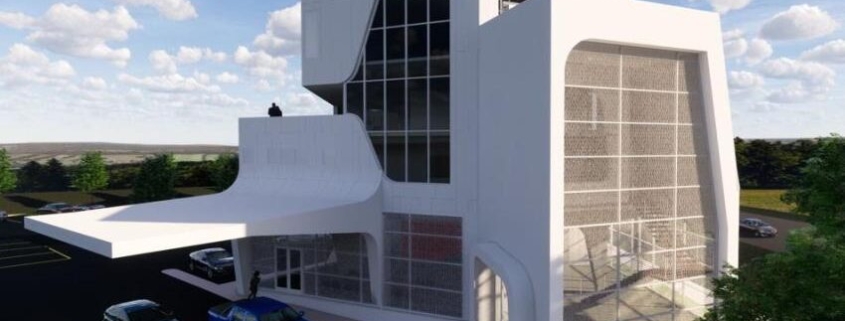When Scott Dube was 12 years old, he knew he wanted to be a doctor. He loved to take things apart and put them together and make them work again. Fixing things was his deal.

Scott Dube
Dube is currently a board-certified orthopedic surgeon, and instead of tinkering with mechanical things, he finesses the nuances of the human body and fixes people, so they can continue to live productive, fulfilled lives.
With five – the fifth to open in December in LaVergne – separate practice locations under his belt as a doctor with a flourishing practice, Dube is currently building a multi-million-dollar facility in Hermitage – projected to open for business in November 2021.
“My area of medicine is a great choice for me,” Dube said. “We get to see people get better. We can fix people. It’s very fulfilling.”
Foreshadowing The Future
Wayne Dube is Scott Dube’s father. He’s retired from the wholesale heating and air conditioning systems supply business. He’s spearheading the construction of his son’s 30,000-square-foot headquarters on Old Lebanon Dirt Pike. They lived in Donelson as Scott Dube grew up, and both currently live at Brandywine Point in Old Hickory.
“He proclaimed early on he wanted to be a doctor,” Wayne Dube said. “He owned his own landscaping business at age 12 and had it through high school. He ended up with about eight employees. He was always self motivated, and that stood out for him. He always had an aptitude for fixing and repairing stuff. He was always mechanically inclined.”
Wayne Dube noted there are no doctors in the immediate family, but five greats back, they had a doctor in the family who practiced in Montgomery. He said his son was always athletic, as well.
Path To Orthopedic Practice
Scott Dube is a graduate of David Lipscomb University and East Tennessee State University School of Medicine.
“I completed my residency at the University of Louisville,” Dube said. “I am lucky to say I started my orthopedic practice near my hometown in Hermitage, where I continue to practice.”
He started Dube Orthopedics and Physical Therapy in 2003.
“I went to Ezell Harding and David Lipscomb,” Dube said.
During his quest, he was able to shadow the famed Dr. Bill Frist.
“I loved shadowing him and was able to watch him perform surgery,” Dube said. “That’s basically when I absolutely knew I would be a doctor.”
Because of the experience, Scott Dube, at first, leaned toward becoming a heart surgeon.
“It was in medical school when I rotated through orthopedics, and we used screws in hips to help people, and I enjoyed the coordination over time, and my past mechanical experience really helped,” Dube said.
Scott Dube currently is a leader in orthopedics and regenerative medicine. He helps relieve pain from damaged joints with minimally invasive partial or complete joint replacement surgery. His general orthopedics practice runs the gamut of reducing pain associated spine-related issues, torn ligaments, broken limbs and arthritis.
“We also work a lot in sports medicine,” Dube said. “We treat a range of sports injuries such as sprains, ALC-MLC tears and other injuries that prevent you from pain-free sports activities,” said Scott Dube, a father of three children.
He said a favorite aspect of his practice is surgery.
“I operate on Tuesdays and Thursdays; those are my best days,” Dube said. “I really enjoy it.”
His bedside manner leans toward more charming than stiff and professional.
“I know a lot of the people I take care of,” Dube said. “I treat everyone just like they are in my family. I treat them like they are my mom or dad.”
Physical therapy is a huge part of his practice.
“It’s more important they you might think,” Dube said. “People live years longer from getting therapy. They get and keep strong. They have a better recovery.”
He has many older clients in their 80s and 90s who get therapy to prevent fractures. He has patients as young a 1 year old. Conservative therapy is Scott Dube’s rule of thumb. He tries shots and different methods first. He’s also dedicated to new and innovative procedures in orthopedics and regenerative medicine.
“The use of stem cells in both the clinic and in surgery has led to unprecedented and accelerated results,” Dube said.
His surgical specialties are knees, shoulders and carpal tunnel. In Scott Dube’s 17-plus year career, so many special moments stand out in his mind. Every week, a patient will approach him and thank him for changing his or her life.
“I did operate on a 103-year-old lady who had a hip fracture,” Dube said. “We were able to give her a few more years of quality living.”
Flourishing Future: Expansion And State-Of-The-Art Facility On Tap
In 17 years, Scott Dube expanded his practice to encompass five locations, and shovels turned ground Oct. 28 at 302 Old Lebanon Dirt Pike in Hermitage. Scott Dube’s original practice is at TriStar Summit Medical Center. Dube will transfer his practice to the new location, but continue to perform surgeries at the hospital. There are also locations in Mt. Juliet, Lebanon, Green Hills and LaVergne, which will open next month.
Scott Dube quipped about choosing the new Hermitage location site.
“I looked a really long time for a place to transfer my home base from Summit Medical Center to a place of our own,” Dube said. “At this place, there’s a Chik-fil-A next door, and you can’t beat a chicken, egg, cheese and bacon sandwich.”
And, Buffalo Wild Wings is a neighbor, as well. On a more serious note, Scott Dube spotted what he liked on a trip he took.
“I liked the design of an orthopedic building up North and went from there,” Dube said.

The front lobby of the Dube Orthopedic Building will showcase a soaring ceilings and stainless steel. The façade of the building will be Swiss white pearl. (PHOTO COURTESY OF SCOTT DUBE)
Wayne Dube is overseeing the construction of the 30,000-square-foot building. He has experience. He built a high-rise condo development in Green Hills, and his son has one of his locations there on the first floor.
“Scott wanted his own space instead of paying rent and a place to expand, as well,” Wayne Dube said. “He chose the spot because it was close to the hospital, and it had good access.”
The lot is 2 acres.
“We closed about six months ago,” said Wayne Dube.
The area has not seen architecture of this stature before. The building will shine in the region with four floors, each 7,500 square feet.
Wayne Dube said the first level will house their physical therapy practice, and the second floor will encompass Dube’s practice. A plastic surgeon and a vascular surgeon already bought the third floor. The fourth floor is open for future doctors.
“It’s a state-of-the-art-looking building,” Wayne Dube said. “It’s very creative and different to the area.”
Scott Dube’s floor will have 12 patient rooms, including an X-ray room, casting room, ultrasound room, his office, meeting room and check-in space.
“The exterior is white Swiss pearl,” said Wayne Dube.
There will be plenty of parking and access to Old Hickory Blvd.
According to Angela Nguyen with Dube Ortho and Physical Therapy, Scott Dube recently hired another doctor, Matthew Sugalski. There is a nurse practitioner and physician’s assistant, six physical therapists and three physical therapy assistants.
“As a father, I have greatly enjoyed working with Scott,” Wayne Dube said. “He’s very creative and ambitious and wants to grow his business.”
Source: Main Street Nashville






